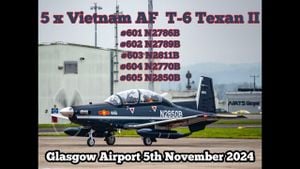Myanmar is currently gripped by internal conflict, with multiple ethnic groups taking up arms against the ruling military junta. Instability began when the military overthrew the democratically elected government led by Aung San Suu Kyi in February 2021, triggering nationwide protests and rebel activity. Amidst this backdrop, notable movements, particularly from the Ta'ang National Liberation Army (TNLA), have surfaced, signaling potential pathways to peace.
The TNLA, which has been engaged intensely with the military, recently expressed its readiness to enter peace talks after enduring substantial hardship along the Myanmar-China border. This shift was reportedly influenced by increased diplomatic pressure from China, which views the turmoil as destabilizing to its own interests.
Initially, following the coup, the TNLA and various other ethnic armed organizations were part of diverged factions fighting against military oppression, seeking autonomy and protections for their communities. Over the past year, violent clashes have been frequent, resulting from greater military offensives and assaults extensively using air power against rebel-held territories.
The TNLA's announcement about being open to dialogue highlights the dire humanitarian situation faced by civilians caught between the warring factions. Lway Yay Oo, a spokesperson for the TNLA, stated, "Our civilians are suffering from airstrikes and other hardships. Therefore, we must find a way to end it." This sentiment resonates deeply within many regions affected by the violence, wherein ordinary people are often the collateral damage during armed conflicts.
Recent clashes have escalated due to continued air operations by the military junta aiming to suppress the insurgence, which had reportedly succeeded in regaining control over several towns lost to rebel forces. The TNLA has been part of broader operations known as 'Operation 1027,' which represented one of the most significant challenges to the junta post-coup. Observers fear the continuing airstrikes will aggravate tensions, leading to potential escalations.
China’s interventions are also noteworthy, as it typically positions itself as the arbiter of peace within the region. Having historically viewed the Myanmar military as a stabilizing force, the recent chaos has likely prompted Beijing to recalibrate its diplomatic strategies, nudging factions toward negotiations. Beijing’s foreign ministry has been encouragedly vocal about fostering dialogue and has called for all parties to engage constructively to minimize the human toll.
On another front, there is rising tension along the border shared between Myanmar and Thailand, particularly concerning the United Wa State Army (UWSA), which operates with quasi-autonomy along the praised focus of Thailand. Recently, Thai authorities requested the UWSA to withdraw its forces from disputed military camps, but this demand was rejected, highlighting the complex and often fraught interactions between ethnic militias and state forces.
The UWSA's leaders articulated their position by stating any proposed troop withdrawal should stem from formal bilateral discussions with the junta, reflecting the pervasive mistrust prevalent among the parties involved. Significantly, the UWSA’s capacity to advance its regional security operates primarily from the approved military bases established since the 1989 peace agreement, earning them significant leverage over the Myanmar military and its western neighbor.
Thailand’s military response has seen troop reinforcements along the border as border disputes recur, with reports of no immediate clashes, yet the standoffs have resulted in increased anxiety among local residents. Concerns remain high as tensions continue to escalate, threatening potential military conflict and jeopardizing the lives of individuals living within the contested territories.
Despite repeated demands from Thailand to pull back forces, history has shown how complex these negotiations become, often stifled by long-standing ethnic grievances. Commentators have noted dependence on military rule hinders the junta's ability to engage meaningfully with territorial disputes or negotiate peace settlements. This failure not only compromises national sovereignty but also the stability of bordering nations.
Colonel Rungkhun Mahapanyawong, the Royal Thai Army’s spokesperson, downplayed the current tensions, labeling the situation as "normal"; yet, such remarks clash with local sentiments feeling the weight of military operations on both sides. Meanwhile, the junta appears disinterested, diverted by its internal crises rendered from coup resistance.
While pressures from multiple factions are mounting, both regional players and ethnic rebels forecast heightened hostilities. This backdrop creates not only humanitarian crises for civilians caught up amid the clashes but also manifests geopolitical consequences impacting China’s stance and regional partnerships.
The overdue desire for dialogue between the TNLA and the junta could suggest necessary pivots forward within Myanmar's fractured environment; nevertheless, the efficacy and authenticity of the military's commitment to peace remain uncertain. All eyes will remain fixed on forthcoming negotiations, as the fate of many hinges precariously upon the dialogue's outcome underlining the producing humanitarian necessity beyond the immediate military confrontation.
At the heart of Myanmar's struggles lies the powerful realization: enduring solutions to decades-old conflicts necessitate more than mere political maneuvering; they require genuine acknowledgment of grievances, the humane treatment of civilians, and authentic commitments to peace across these deeply polarized factions. The world looks on as these forces converge, searching for stability amid the chaos, grappling with history's weight on their shoulders.



